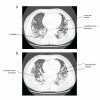Chest Radiological Findings and Clinical Characteristics of Laboratory-Confirmed COVID-19 Patients from Saudi Arabia
- PMID: 34518506
- PMCID: PMC8449511
- DOI: 10.12659/MSM.932441
Chest Radiological Findings and Clinical Characteristics of Laboratory-Confirmed COVID-19 Patients from Saudi Arabia
Abstract
BACKGROUND Coronavirus disease 2019 (COVID-19) is a viral respiratory disease that first emerged in China in December 2019 and quickly spread worldwide. As the prevalence of COVID-19 increases, radiological examination is becoming an essential diagnostic tool for identifying and managing the disease's progression. Therefore, we aimed to identify the chest imaging features and clinical characteristics of patients with laboratory-confirmed COVID-19 in Saudi Arabia. MATERIAL AND METHODS In this retrospective study, data of laboratory-confirmed COVID-19 patients were collected from 4 hospitals in Jeddah, Saudi Arabia. Their common clinical characteristics, as well as imaging features of chest X-rays and computed tomography (CT) images, were analyzed. RESULTS A total of 297 patients with laboratory-confirmed COVID-19 who underwent chest imaging were investigated in this study. Of these patients, 77.9% were male and 22.2% were female. Their mean age was 48 years old. The most common clinical symptoms were fever (187 patients; 63%) and cough (174 patients; 58.6%). The predominant descriptive chest imaging findings were ground-glass opacities and consolidation. Locations of abnormalities were bilateral, mainly distributed peripherally, in the lower lung zones, and in the middle lung zones. CONCLUSIONS This study provides an understanding of the most common clinical and radiological features of patients with laboratory-confirmed COVID-19 in Saudi Arabia. The majority of COVID-19 patients in our study cohort had either stable or worse progression of lung lesions during follow-ups; thus, they presented moderate disease cases. Elderly males were more affected by COVID-19 than females, with fever and cough being the most common clinical symptoms.
Conflict of interest statement
None declared.
Figures





References
-
- Zhou S, Wang Y, Zhu T, Xia L. CT features of coronavirus disease 2019 (COVID-19) pneumonia in 62 patients in Wuhan, China. Am J Roentgenol. 2020;214(6):1287–94. - PubMed
-
- Barry M, Ghonem L, Alsharidi A, et al. Coronavirus disease-2019 pandemic in the Kingdom of Saudi Arabia: Mitigation measures and hospital preparedness. Journal of Nature and Science of Medicine. 2020;3(3):155.
MeSH terms
LinkOut - more resources
Full Text Sources
Medical
Research Materials

